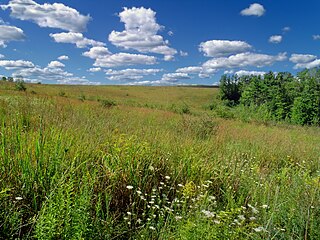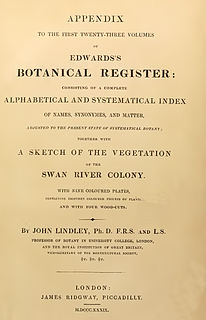
Caladenia longicauda subspecies borealis, commonly known as daddy-long-legs spider orchid is a plant in the orchid family Orchidaceae and is endemic to the south-west of Western Australia. It has a single hairy leaf and up to three mostly white flowers with long, drooping sepals and petals.

Caladenia attingens, commonly known as mantis orchids, are plants in the orchid family Orchidaceae and are endemic to the south-west of Western Australia. There are three subspecies, each of which has a single hairy leaf and one or two brightly coloured flowers with upswept sepals and a labellum with long, comb-like fringes. The subspecies differ in size, distribution and habitat.
Caladenia bicalliata subsp. cleistogama, commonly known as the shy limestone spider orchid or sandhill spider orchid, is a plant in the orchid family Orchidaceae and is native to the south-west of Western Australia. It has a single erect, hairy leaf and one or two cream-coloured flowers which are smaller than those in subspecies bacalliata.
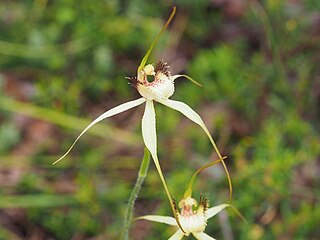
Caladenia busselliana, commonly known as Bussell's spider orchid, is a plant in the orchid family Orchidaceae and is endemic to a small area in the south-west of Western Australia. It is a rare orchid with an erect, hairy leaf and up to three pale yellow flowers. Only about fifty specimens are known and it is threatened by habitat destruction and by too-frequent or too infrequent bushfires.
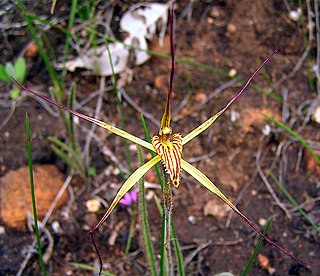
Caladenia caesarea subsp. caesarea, commonly known as the mustard spider orchid, is a plant in the orchid family Orchidaceae and is endemic to the south-west of Western Australia. It has a single spreading, hairy leaf and up to three mustard-coloured flowers with red stripes. It was originally described as a subspecies of Caladenia filamentosa but the rich colour of its flowers and prominent labellum separate it from that species.

Caladenia caesarea subsp. maritima, commonly known as the cape spider orchid, is a plant in the orchid family Orchidaceae and is endemic to the south-west of Western Australia. It has a single spreading, hairy leaf and up to three small mustard-coloured flowers with red stripes. It is only known from a small coastal area near Cape Leeuwin where it grows in clumps of ten or more.
Caladenia caesarea subsp. transiens, commonly known as the dwarf mustard spider orchid, is a plant in the orchid family Orchidaceae and is endemic to the south-west of Western Australia. It has a single spreading, hairy leaf and up to three small lemon-yellow flowers with red stripes. It is only known from a single small population near the town of Williams.
Caladenia citrina, commonly known as the Margaret River spider orchid, is a plant in the orchid family Orchidaceae and is endemic to the south-west of Western Australia. It has a single erect, hairy leaf and up to three lemon-yellow flowers. It has a narrow distribution in the far south-west corner of Western Australia.
Caladenia denticulata subsp. albicans, commonly known as the alabaster spider orchid, is a plant in the orchid family Orchidaceae and is endemic to the south-west of Western Australia. It has a single erect, hairy leaf and one or two pale creamy-white flowers which have a white labellum with red markings. The only known population occurs in a small area near Arrowsmith.
Caladenia denticulata subsp. rubella, commonly known as the clumped spider orchid, is a plant in the orchid family Orchidaceae and is endemic to the south-west of Western Australia. It has a single erect, hairy leaf and one or two dull or pinkish red flowers with prominent dull red markings and with a white labellum with red markings.
Caladenia erythronema, commonly known as the red thread spider orchid, and Nyabing spider orchid is a plant in the orchid family Orchidaceae and is endemic to the south-west of Western Australia. It has a single hairy leaf and up to three red, yellow or cream-coloured flowers with dangling, thread-like sepals and petals and a small labellum.
Caladenia exilis subsp. vanleeuwenii, commonly known as the Moora spider orchid, is a plant in the orchid family Orchidaceae and is endemic to the south-west of Western Australia. It is a relatively rare spider orchid with a single erect, hairy leaf and up to three variably-coloured flowers with a small white, red-striped labellum. It differes from subspecies exilis in having variably coloured flowers, different growth habit, earlier flowering and different habitat.

Caladenia longicauda subsp. longicauda, commonly known as the white spider orchid, is a plant in the orchid family Orchidaceae and is endemic to the south-west of Western Australia. It has a single hairy leaf and up to four, mostly white flowers with long drooping, thread-like ends on the sepals and petals. It grows in woodland and forest.

Caladenia attingens subsp. attingens, commonly known as the forest mantis orchid or sneezing spider orchid, is a species of orchid endemic to the south-west of Western Australia. It is a relatively common orchid with a single erect, hairy leaf and one or two green, yellow and red flowers. It is similar to the fringed mantis orchid but has smaller flowers and has a more southerly distribution.

Caladenia attingens subsp. gracillima, commonly known as the small mantis orchid, is a species of orchid endemic to the south-west of Western Australia. It is a relatively common orchid with a single erect, hairy leaf and one or two green, yellow and red flowers. It differs from subspecies attingens in having smaller flowers and a more easterly distribution.
Caladenia attingens subsp. effusa, commonly known as granite mantis orchid, is a subspecies of orchid endemic to the south-west of Western Australia. It has a single erect, hairy leaf and one or two green, yellow and red flowers. It differs from the other subspecies of Caladenia attingens in having smaller flowers with lateral sepals which are not upswept and a labellum which is less than 15 mm (0.6 in) wide.

Caladenia longicauda subsp. merrittii, commonly known as Merritt's white spider orchid, is a plant in the orchid family Orchidaceae and is endemic to the south-west of Western Australia. It has a single hairy leaf and up to three large, mainly white flowers with very long, drooping lateral sepals and petals, and a white broad labellum with relatively short labellum teeth. It is one of the largest spider orchids.
Caladenia longicauda subsp. insularis, commonly known as the island white spider orchid is a plant in the orchid family Orchidaceae and is endemic to the south-west of Western Australia. It has a single hairy leaf and up to four yellowish-white flowers with long, mostly spreading lateral sepals and petals. It is a relatively rare, self-pollinating subspecies and often flowers which are in bud, open and finished are seen on a single plant.

Caladenia straminichila, commonly known as the Tenterden yellow spider orchid, is a species of orchid endemic to the south-west of Western Australia. It has a single erect, hairy leaf and one or two pale yellow flowers which have a red-striped labellum with short teeth on its sides.
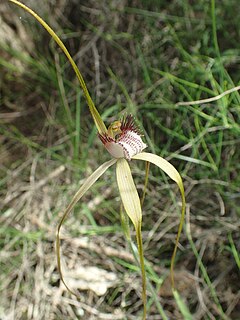
Caladenia swartsiorum, commonly known as the Island Point spider orchid, is a species of orchid endemic to the south-west of Western Australia. It has a single erect, hairy leaf and up to three pale greenish-yellow and white flowers and is only known from a small area near the Harvey Estuary.






